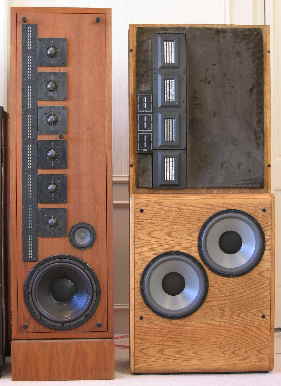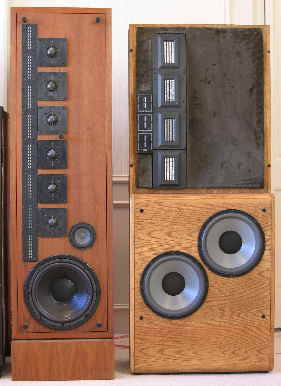 Note how the QLS, on the left side of this photo, has a vertical line of tweeters next to a similarly placed line of midrange drivers. (Just for future discussions on the upcoming PS Audio speakers based on Nudell's Magnum Opus design also note the small woofer above the bigger one—the first implementation of Arnie's midbass coupler which will be one of two centerpieces of our new design). Now, compare that to the 4.5 with its three vertical EMITs (Electro Magnetic Induction Tweeter) and line of 4 EMIM (Electro Magnetic Induction Midrange) planar midranges. These form a quasi-line source for the midrange and appear to be the basis of a line source attempt for the tweeters—yet that would be only partially correct.
The tweeter array form Infinity's first (to my knowledge) implementation of a progressive crossover: a line source moving to a point source. At low frequencies, all three tweeters are operating together to match the top of the midrange line source. As the music goes up in frequency the outer two pair progressively turn off leaving only the single middle "point source" tweeter for the high frequencies. Thus, the 4.5 combined a quasi-line source midrange with a progressive crossover point source. The advantages of this are a far less abrupt transition from line source to point source.
More tomorrow.
Note how the QLS, on the left side of this photo, has a vertical line of tweeters next to a similarly placed line of midrange drivers. (Just for future discussions on the upcoming PS Audio speakers based on Nudell's Magnum Opus design also note the small woofer above the bigger one—the first implementation of Arnie's midbass coupler which will be one of two centerpieces of our new design). Now, compare that to the 4.5 with its three vertical EMITs (Electro Magnetic Induction Tweeter) and line of 4 EMIM (Electro Magnetic Induction Midrange) planar midranges. These form a quasi-line source for the midrange and appear to be the basis of a line source attempt for the tweeters—yet that would be only partially correct.
The tweeter array form Infinity's first (to my knowledge) implementation of a progressive crossover: a line source moving to a point source. At low frequencies, all three tweeters are operating together to match the top of the midrange line source. As the music goes up in frequency the outer two pair progressively turn off leaving only the single middle "point source" tweeter for the high frequencies. Thus, the 4.5 combined a quasi-line source midrange with a progressive crossover point source. The advantages of this are a far less abrupt transition from line source to point source.
More tomorrow.
Quasi line source
by Paul McGowan
In yesterday's post, I told you about the QLS, Infinity's first line source loudspeaker. As a reminder, line source loudspeakers, though rare because of the expense of all the required driver elements, are fundamentally different radiators than point sources and—because thankfully many of my readers work hard to keep me accurate as well as precise—I should point out there's no such things as a true point source (an infinitely small radiating source) and very few true line sources (like the Infinity IRS and Genesis One).
Following the '76 introduction of the QLS, itself not a full-height line source but the closest thing Infinity had ever attempted, Arnie and company launched what few people remember: a quasi line source called the 4.5. Here's a picture (from the website David's Audio) of the 4.5 and the QLS together.
 Note how the QLS, on the left side of this photo, has a vertical line of tweeters next to a similarly placed line of midrange drivers. (Just for future discussions on the upcoming PS Audio speakers based on Nudell's Magnum Opus design also note the small woofer above the bigger one—the first implementation of Arnie's midbass coupler which will be one of two centerpieces of our new design). Now, compare that to the 4.5 with its three vertical EMITs (Electro Magnetic Induction Tweeter) and line of 4 EMIM (Electro Magnetic Induction Midrange) planar midranges. These form a quasi-line source for the midrange and appear to be the basis of a line source attempt for the tweeters—yet that would be only partially correct.
The tweeter array form Infinity's first (to my knowledge) implementation of a progressive crossover: a line source moving to a point source. At low frequencies, all three tweeters are operating together to match the top of the midrange line source. As the music goes up in frequency the outer two pair progressively turn off leaving only the single middle "point source" tweeter for the high frequencies. Thus, the 4.5 combined a quasi-line source midrange with a progressive crossover point source. The advantages of this are a far less abrupt transition from line source to point source.
More tomorrow.
Note how the QLS, on the left side of this photo, has a vertical line of tweeters next to a similarly placed line of midrange drivers. (Just for future discussions on the upcoming PS Audio speakers based on Nudell's Magnum Opus design also note the small woofer above the bigger one—the first implementation of Arnie's midbass coupler which will be one of two centerpieces of our new design). Now, compare that to the 4.5 with its three vertical EMITs (Electro Magnetic Induction Tweeter) and line of 4 EMIM (Electro Magnetic Induction Midrange) planar midranges. These form a quasi-line source for the midrange and appear to be the basis of a line source attempt for the tweeters—yet that would be only partially correct.
The tweeter array form Infinity's first (to my knowledge) implementation of a progressive crossover: a line source moving to a point source. At low frequencies, all three tweeters are operating together to match the top of the midrange line source. As the music goes up in frequency the outer two pair progressively turn off leaving only the single middle "point source" tweeter for the high frequencies. Thus, the 4.5 combined a quasi-line source midrange with a progressive crossover point source. The advantages of this are a far less abrupt transition from line source to point source.
More tomorrow.
 Note how the QLS, on the left side of this photo, has a vertical line of tweeters next to a similarly placed line of midrange drivers. (Just for future discussions on the upcoming PS Audio speakers based on Nudell's Magnum Opus design also note the small woofer above the bigger one—the first implementation of Arnie's midbass coupler which will be one of two centerpieces of our new design). Now, compare that to the 4.5 with its three vertical EMITs (Electro Magnetic Induction Tweeter) and line of 4 EMIM (Electro Magnetic Induction Midrange) planar midranges. These form a quasi-line source for the midrange and appear to be the basis of a line source attempt for the tweeters—yet that would be only partially correct.
The tweeter array form Infinity's first (to my knowledge) implementation of a progressive crossover: a line source moving to a point source. At low frequencies, all three tweeters are operating together to match the top of the midrange line source. As the music goes up in frequency the outer two pair progressively turn off leaving only the single middle "point source" tweeter for the high frequencies. Thus, the 4.5 combined a quasi-line source midrange with a progressive crossover point source. The advantages of this are a far less abrupt transition from line source to point source.
More tomorrow.
Note how the QLS, on the left side of this photo, has a vertical line of tweeters next to a similarly placed line of midrange drivers. (Just for future discussions on the upcoming PS Audio speakers based on Nudell's Magnum Opus design also note the small woofer above the bigger one—the first implementation of Arnie's midbass coupler which will be one of two centerpieces of our new design). Now, compare that to the 4.5 with its three vertical EMITs (Electro Magnetic Induction Tweeter) and line of 4 EMIM (Electro Magnetic Induction Midrange) planar midranges. These form a quasi-line source for the midrange and appear to be the basis of a line source attempt for the tweeters—yet that would be only partially correct.
The tweeter array form Infinity's first (to my knowledge) implementation of a progressive crossover: a line source moving to a point source. At low frequencies, all three tweeters are operating together to match the top of the midrange line source. As the music goes up in frequency the outer two pair progressively turn off leaving only the single middle "point source" tweeter for the high frequencies. Thus, the 4.5 combined a quasi-line source midrange with a progressive crossover point source. The advantages of this are a far less abrupt transition from line source to point source.
More tomorrow.
- Choosing a selection results in a full page refresh.
- Opens in a new window.








